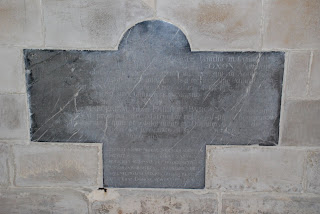 |
| The Effigy of Thomas Chafe of Dodscott St Giles in the Wood, Devon, England |
The inscription reads:
Which translates as:In
Piam
THOMAE CHAFE
Generosi memoriam
Ex per antiqua CHAFORUM de CHAFE-COMBE familia in Comitatu
SOMERSET oriundi; ex collegio EXON in Academia OXON Artium
Magistri; viri probitate, virtute, ac ingenio insigis; qui in Apostolica
fide constante versatus, in beatae justorum, resurrectionis spe Animam
expiravit XXVto die Novemb Anno salutis, 1648
aetatisq suae Climacterico Magno
eXVVIas sVas eXVIt MeDICVs
Uxorem reliquit MARGERIAM, filiam PHILIPPI BURGOYNE clarrissima
BURGOYNORUM prosapia orti; Matronam religiosissimam bonorumq
operum plenissimam quae et obdormiuit in Domino die
Anno a Chro nato 16 aetatis
vero suae
ABSTULIT A NOBIS MISERE QUEM FLEM' ADEMPTUM
AESTULIT E VIVIS MORTIS INIQUA MANUS
NEC CECIDIT SOLUS; NAMQ ET PRUDENTIA VIRTUS,
CANDOR, AMOR, PIETAS, INTERIERE SIMUL,
TESTE VEL INVIDIA, VITA EST, LETHOQ BEATUS
VIVUS ERAT DOMINI, MORTUUS IN DOMINO
In pious memory of the noble Thomas Chafe arisen from the very ancient family of the Chafes from Chaffcombe in the county of Somerset, Master of Arts from Exeter College in the University of Oxford; a man remarkable in probity, virtue and character who having been devoted in constant apostolic faith breathed out his spirit on the 25th day of November in the year of grace 1648 and in his grand climacteric year, in hope of the blessed resurrection of the Just. The doctor rejoiced exceedingly at his loud howlings. He left a wife Margery, daughter of Philip Burgoyn sprung from the most famous stock of the Burgoyns, a most religious matron and most full of good works who too went to sleep in Christ on the [blank]day of [blank] in the year since the birth of Christ 16[blank] of her age [blank]Thomas Chaffe (abt 1585 -1648) of Dodscott was the third son of Thomas Chaffe of Exeter (? -1604) and Dorothy Shorte (? -1612). His sister, Pascoe Chafe, was the wife of Tristram Risdon of Winscott (abt 1580-1640), author of The Chorographical Description or Survey of the County of Devon. Thomas married Margaret Burgoyne (? -1655). In his will dated September 24, 1648 he appoints his "hopeful godson and young nephew" Thomas Chafe (1611-1662) executor and directs him to inter his body "as neere as he can by my sister Risedon, and I doe ordain appointe and require £30 rather more than lesse to be bestowed in a monument of my Effigies by my Esecutor, of whose ove herin I am no diffident, who have reaped so many gratuities formely from mee, and now in present burthening his conscience for effecting it as he shall answer coram Deo. I desire him to inscript in my monument some memory of his good Aunt Risedon, and of the family deceased there interred, also of my wife and her two children, noe great onus to an ingenious, generous, and gratefull minde." Thomas Chafe was buried at St Giles in the Wood on 29 Nov 1648.
He took away from us misery
He took away from the living the unjust hand of death
Neither did he fall alone, for prudence, virtue
Honesty, love and piety perished at the same time
With envy as witness [unknown]
Of the Lord he was alive, he died in the Lord
The dates of Margaret Burgoyne's death and burial were never inscribed on the monument. Her burial on 30 Mar 1655 is recorded in the St Giles in the Wood parish register.
The effigy is described in detail in Charles Worthy's Devonshire Wills, published in 1896:
In accordance with his uncle's injunctions, Thomas Chafe erected in the chancel of St. Giles, and within the altar-rails, a high tomb to the memory of deceased, with his effigy thereon. The figure, with moustache and peaked beard, is lying upon the right side, the face supported by the hand, the elbow resting upon a cushion. The costume consists of a coif or skull-cap which entirely conceals the hair, a short cloak with tight sleeves, and which being open in front shows that the body is protected by a cuirass, frequently worn in those troublous times, fastened down the front with studs; breeches and long stockings gartered below the knee with roses or knots, and on the feet are low shoes similarly decorated. There were also two female figures, who probably represented the two children referred to in the will. Over the figure are three coats of arms. In the centre the ancient, but questionable, arms of Chafe, already blazoned, with mantling and crest: A demi lion ramp. or, holding between its paws a fusil, az.
On the dexter side; Chafe impaling Burgoyne: Az. a talbot pass. arg. in chief a mullet.
And on the sinister side; Risdon: Arg. 3 bird bolts sa., impaling Chafe.
 |
| Thomas Chafe's epitaph |
When the church was rebuilt in 1862 the effigy was removed from its original position in the chancel within the alter rails and placed against the south wall of the tower. Worthy writes, "The two female figures then disappeared; and I understand that 'they fell to pieces, and could not be put together again.'"
In 1987 the effigy was carefully restored, and placed in the newly created Mary Withecombe Chapel.
Sources:
Worthy, Charles. Devonshire Wills. Bemrose & Sons, 1896.
Worthy, Charles. “Thomas Chafe, of Doddescote, Gentleman.” Report & Transactions of the Devonshire Association, vol. 19, 1887, pp. 531–537.






